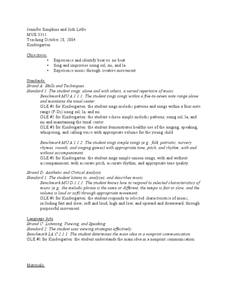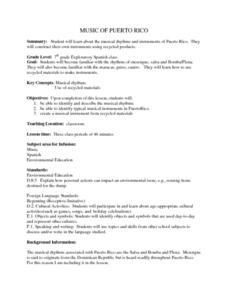Curated OER
Rhythm, Triads, Intervals
Let the class show what they know about rhythm, triads, and intervals with this quiz. They complete the rhythm on staff one and two, identify the intervals on staff three, and identify the triads on staff four. This is a well-thought-out...
Curated OER
Triads - 7th Chords - Major/Minor Keys - Rhythm
Budding musicians transpose chords, identify major and minor keys, and complete measures to match the shown signatures. This resource can be used as a quiz, test, or as practice for those learning how to read and write music.
Curated OER
Kindergarten Music Time
Little ones are led through a series of rhythmic songs and chants while they march, clap, and use their tummies as percussive instruments. They work on singing in pitch, chunking, and keeping a steady beat.
Special needs in Music
Music Work Sheet (Special Ed)
Music is beneficial for all learners. Help your learners with special needs learn about different styles of music, as well as the ways that music is represented on paper, with 30 different worksheets.
Curated OER
Music and Animation: 200 Greatest Pop Culture Icons
Music has been used to convey thoughts, feelings, and the human condition for thousands of years. Your class will analyze several songs hear in the animated classic, "Charlie Brown." They will listen to several jazz pieces from the show,...
Curated OER
Middle School General Music Unit Plans
Here's a collection of unit plans for middle school musicians. Topics include the mbira, opera, rhythm and culture, music in Africa, music in the movies, music theory and notation, blues and jazz, and the ocarina. Definitely worth a look.
Curated OER
Kodaly Beat Lesson
Introduce rhythmic beat and melodic beat with a upbeat activity that asks young musicians to clap the beat to their favorite nursery rhyme. To introduce the rest beat, class members use small drums or other percussion instruments to play...
North Carolina Standard Curriculum
Rhythm Counting
Understanding time signatures and rhythm counting are two very important parts of playing an instrument well. Here are three basic lessons rolled into one that prompt upper graders to play their instruments with care. They'll practice...
Curated OER
Music and Emotion
Students identify the various emotions created by different types of music. They Identify role of music in creating various emotions for film and television . They observe and practice various ways of playing percussion instruments. They...
Curated OER
Same and Different Through Music and Art
This instructional activity is intended for a music class but would be a great way to teach compare and contrast to any class. Kindergarteners dance the Hokey Pokey to four different styles of music and examine two paintings of Humpty...
Curated OER
Identifying the Beat
Sixth graders listen to various songs. In this musical properties lesson plan, 6th graders work in groups to identify musical selections, practice tapping the beat, review time signatures, and identify the meter of different songs.
Curated OER
Band Beats
Learners discuss find out about the four types of musical instruments. They identify several instruments of each type. Students listen to a simple rhythmic music. They follow along with its notation. Learners identify treble and bass...
Curated OER
Rhythm and Improv, Jazz and Poetry
Connect the ideas of jazz improvisation and art to writing poetry. Learners collaborate and write different lines of poetry, imitating the jazz styles of improvisation and freewriting. Take a close look at the poems "Tenebrae" by Yusef...
Curated OER
Transferring Rhythmic Patterns From Music to Movement
Learners identify and demonstrate movement elements in relation to musical notation. They clap to rhythms, beat on drums, match musical notes to speech patterns and use the rhythms of the their names to create a dance.
K20 LEARN
Watch Your Tone: Tone Analysis Through Music And Nonfiction
Identifying the tone of a piece of writing or the author's attitude toward the subject matter can be difficult for learners. Simplify the process with a lesson that begins with skits, moves to songs and their lyrics, and then to passages...
Concordia College Archives
History and Musical Aesthetics
What are the musical elements that characterize a school's fight song or its alma mater? Class members listen to examples of fight songs and alma maters from various schools, play a listening game, and then create a list of the...
Fun Music Company
Treasure Island Clues: Rhythm
Designed for rhythm level 1, the two games in this packet ask young musicians to identify the number of beats represented by a series of notes and notations, and then to use those numbers to answer a music trivia question.
Literacy Volunteers of Greater Hartford
Similes Activity using Jazz (featuring Duke Ellington)
Language learners get into the swing of things with a jazzy lesson about similes. They read an article about Duke Ellington, listen to samples of his music, and then try their hand at crafting similes to describe his improvisational and...
EBSCO Industries
Music and Poetry
Song lyrics, like poems, are meant to be heard. After examining the literary devices in several poems, scholars examine the lyrics of popular songs and identify the sound devices and the figurative language writers use to create the...
Curated OER
Singing: Mi, So, La
Little ones learn the tones mi, so, and la by singing an answer to a sung question. They play a name game to identify beat, then discuss songs with no beat. If there is time during this musical instruction lesson, they dance about the...
Curated OER
Rhythm Stars
Students listen, clap, compose and identify various rhythms. In this rhythm lesson, students practice rhythm with rhythm cards. Students become familiar with stick notation. Students glue Popsicle sticks to illustrate rhythms.
Poetry4kids
Rhythm in Poetry: The Basics
What makes a great poem sound so good? Learn the rhythmic secrets of poetry with an explanatory online lesson.
Curated OER
Music of Puerto Rico
Seventh graders study about the musical rhythms and instruments of Puerto Rico. Then they construct their own instruments using recycled products. Students listen to different genres of music and define them. Students focus on the...
Curated OER
Rhythm in Motion
Any age of elementary student can demonstrate their understanding of the connections of elements of art and music by creating their own slit song. You will investigate and study the Melanesian Slit Song with Kindergartners through Junior...

























